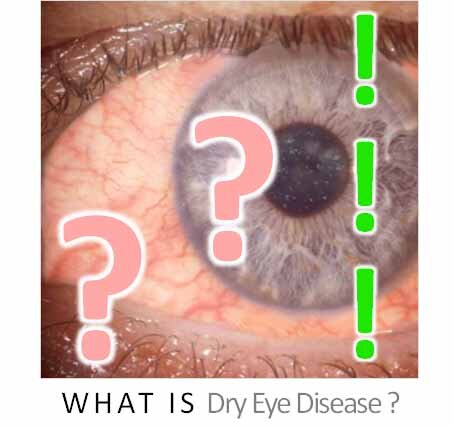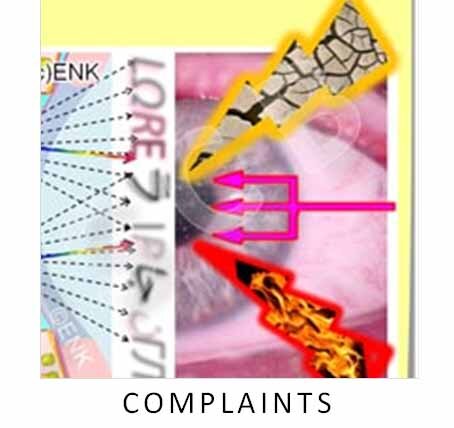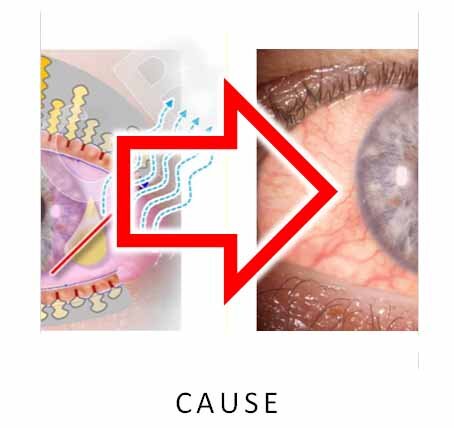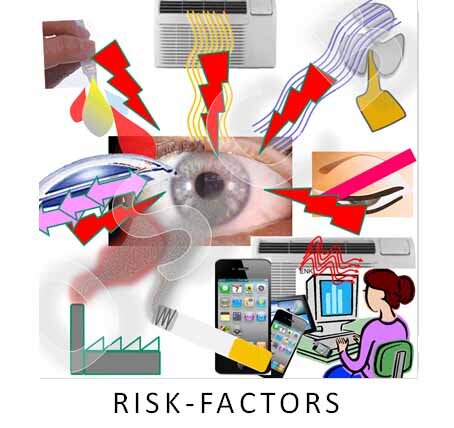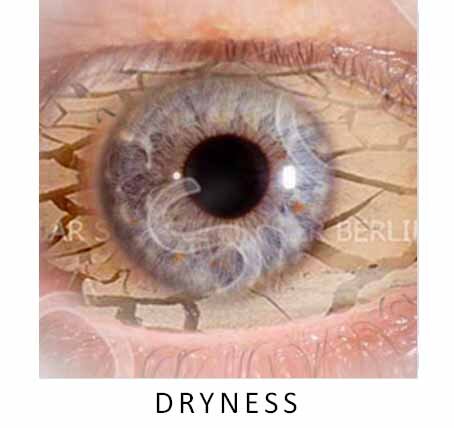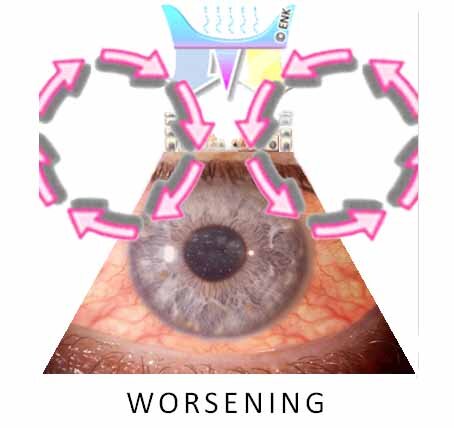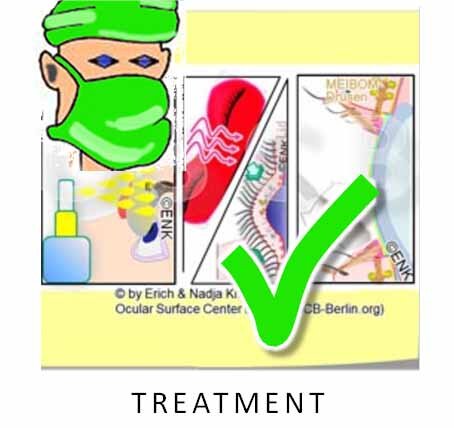Links to the CHAPTERS: [ HOME-Page ] [ FACTS & INFORMATION ] [ RECOGNIZE & TREAT ]
More information about Dry Eye Disease
On this page you will find some more background information to better understand the preceding FACTS page
Dry eye patients have many questions
Patients with so-called 'dry eyes', typically suffer from the disease of the dry eye with the corresponding complaints. Such patients have many questions.
These questions are answered below so that patients can better understand their illness and the options for diagnosis and treatment.
Questions and answers about Dry Eye Disease
(´Click´ on an image for the answers)
1. Facts are simple
What is Dry Eye Disease ?
In medical terms it is also called Keratoconjunctivitis sicca or Sicca syndrome
The Sjogren syndrome is a very specific type of dry eyes and based on a rare disorder of the lacrimal gland
Meibomian gland dysfunction (MGD) is a common cause of dry eyes ...
... and Dry Eye Disease itself is the most common disease in ophthalmology !
2. Complaints are various
What are the symptoms and complaints of Dry Eye Disease ?
Dry eye disease can cause many different symptoms - How do I recognize a dry eye ?
My eyes are often very dry ... and I have a gritty sandy sensation like foreign bodies in my eyes !
My eyes are often burning and red ... and I always have so heavy tired eyes and eye fatigue
In the morning I often have sticky eyes and can hardly open my eyelids !
Why are my eyes often so dry ... but sometimes wet and watery ?
My vision is often blurry - but it gets better after a few eyelid blinks !
The doctor says my dry eye has gotten much better - but I'm still in a lot of pain !
What is chronic pain syndrome ?
3. Cause is a disorder of the tear film
What is the cause of Dry Eye Disease - How does dry eye disease come about ?
What is the ´ocular surface´ ?
What is the ´tear film´ ? - What is the tear film made of ?
Why are tear film disorders so harmful to the eye ?
I used to like my contact lenses - but now I can hardly tolerate them any more !
4. Risk factors are important
Are there risk factors for dry eyes ?
When I work on the computer in the office, my dry eye is worst !
I have the most complaints while driving a car !
During the heating season in winter my dry eye always gets worse !
Is it possible that chronic disease and medication can influence my dry eyes ?
after eye surgery a dry eye may occur, become worse or is first noticed
5. Dryness has various reaons
Aqueous lack of tears is usually not a primary triggering factor
… but instead, a lack of oil with subsequent evaporation of the tear water is typically much more common.
Eyelid disorders also play an important role !
The ´office eye´ combines many desiccating factors and is frequent particularly among younger people
6. Damage is a consequence of dryness
Dryness leads to tissue damage
Tissue damage leads to nerve irritation with feelings of irritation and pain
Advanced Dry Eye Disease can lead to destruction of the ocular surface
7. Worsening is typical in Dry Eyes
When does a dry eye turn into Dry Eye Disease ?
Why does Dry Eye Disease tend to get worse without adequate treatment ?
What are vicious circles of disease worsening ?
Why can a dry eye cause inflammation ?
What role does inflammation play in Dry Eye Disease ?
8. Therapy - there are several options
besides the aim to reduce risk factors as much as possible …
… there are many options for the therapy of dry eyes
What is Dry Eye Disease ?
Dry eyes, or rather the dry eye disease, is a chronic irritation and damage to the tissue at the surface of the eye.
The healthy eye surface must be moist to stay healthy - always and everywhere !!! - even with open eyelids. Therefore the ocular surface is covered by a tearfilm.
A dry eye is typically triggered by any lack or deficiency of the tear film on the eye.
This leads to eye irritation and complaints such as a gritty sandy feeling, or a burning sensation, pain, and sticky eyes.
Especially at the beginning of the condition and in people of advanced age, the irritation can also lead to wet eyes and tears running down the cheeks.
Redness
The inflammatory stimulus, which is triggered by the chronic irritation of the eye, also leads to a dilation of the blood vessels and thus to reddening of the eye.
However, the reddening is usually only moderate in this condition.
What is Keratoconjunctivitis sicca ?
The ophthalmologist also describes dry eye disease as “keratoconjunctivitis sicca” . Sicca means 'dry' and keratoconjunctivitis indicates ´inflammation´. Keratoconjunctivitis sicca therefore means " dry/ dryness inflammation of the cornea and conjunctiva ".
This term is partially misleading because many dry eye patients first have wet eyes with teardrops running over their cheeks. This is because the irritated eye tries to wash away the stimulus through strong tear production. Although it is often helpful in cases of a foreign body - this does unfortunately not help in chronic irritation of the ocular tissue itself.
In recent years it has been scientifically proven that inflammation often develops in dry eye disease. The disease and the complaints of the patient continue to worsen through the inflammatory process.
What is Sicca syndrome ?
Sicca syndrome is another medical term for dry eye disease.
Here, too, the term ´sicca´ focuses on dryness of the eye - which is not always the case as mentioned before, since many patients can have a wet eye, at least initially.
The term ´syndrome´ describes that this condition leads to a ´bundle´ of different complaints in the patient. At first glance, these various complaints may appear uncharacteristic and unrelated.
What is Sjögren's syndrome ?
If selectively the production of aqueous tears is reduced by damage to the lacrimal gland, this is called Sjögren´s syndrome - for further details, please see below .
Therapy of Dry Eye Disease : → Timely and adequate treatment of the dry eye is important in order to avoid permanent damage to the eyes
The good news is that every patient can do a lot to improve the symptoms with a dry eye.
How common is the dry eye?
The dry eye is the most common disease in ophthalmology :
about 1/6 of the population is affected on average in Europe and North America
with about 1/3 of the population, the frequency of disease in Asia is about twice as high
with about 2/3 of the population in Asia, the frequency of Meibomian gland dysfunction is roughly twice as high as dry eye disease itself.
Meibomian gland dysfunction is the most common cause of dry eye, but it does not always lead to immediate complaints
the frequency of Dry Eye Disease is increased in certain conditions, e.g.
in women and
in advanced age
... this indicates an influence of hormones and aging processes.
Not every dry eye is recognized correctly, since the symptoms are often uncharacteristic at first and the onset is often gradual.
Complaints in Dry Eye Disease
What typical dry eye complaints ? - How do I recognize a dry eye?
The symptoms in Dry Eye Disease can be very different and therefore are often non-specific. Most dry eye complaints are due to eye irritation and tear film disorders:
Irritation and pain can be very different
wet eyes with tears running down over the cheeks
pain and chronic pain syndromes
Irritation and pain can be felt in different places:
Although the origin of the disorder is always on the front of the eye, the patient often perceives disturbing sensations or pain in various places:
on the surface of the eye itself
around the eye
on or behind the eyelids
occasionally even behind the eye
Disorders of the tear film can also lead to blurred vision and photophobia
For the reliable diagnosis of Dry Eye Disease, you should contact your ophthalmologist, who can investigate your condition more closely with clinical tests.
Gritty sandy feeling and itchy eyes
Gritty sandy feeling as if there were small foreign bodies in the eye and occasionally itchy eyes are common and annoying complaints in a dry eye.
The typical lack of tears or, more specifically, disturbed wetting of the surface, leads to poorer ´lubrication´ between the eyelids and the eyeball.
Poor lubrication creates an increased friction with all movements of the eye and especially with the frequent normal eyelid blinks that spread the tear film.
Any lack of tears will damage the surface of the eye !
The increased friction leads to constant small micro-injuries to the superficial cell layer on the eye, which causes subliminal pain. We take this as rubbing or as a gritty sandy sensation and, if it occurs constantly, also as a feeling of pressure.
Burning eyes and Dry Spots
A burning sensation is a typical complaint in dry eyes with an unstable tear film. A thinning and eventual rupture of the tear film causes "dry spots" on the ocular surface.
Dry spots can result in increased mechanical friction and increased salt concentrations. When tear water evaporates too quickly, there is a locally increased concentration of the dissolved salts and proteins in the tear film. This is referred to in the specialist literature as increased osmolarity/ hyperosmolarity.
Both, mechanical and chemical stress typically cause wounding of the cells and activation of adjacent nerve fibers which transmit signals to the brain. The patient perceives such signals as irritation or pain. 'Burning' is thought to occur particularly with hyperosmolarity. Mechanical and chemical stimuli can both trigger an inflammatory response.
Tired eyes, heavy eyelids, feeling of pressure and pain
The constant dryness and irritation of the surface of the eye leads to the sensation of ´tired eyes´, ´heavy lids´ or ´sticky eyes´.
Also, a feeling of pressure and pain may occur - this can be felt in very different locations: at the front of the eye or under the eyelids but also around the eye and even behind the eye. To further clarify whether it is really a dry eye, you should see an ophthalmologist !
Tired eyes, heavy eyelids and also a feeling of pressure can perhaps best be explained by the increased mechanical friction between the eyelids and eyeball with each of the numerous necessary eyelid blinks. As a result, the eyelids become 'heavy' and the frequent blinking with its constant irritation becomes tiring.
Sticky eyes and incrustations
A temporary increase in mucus production and possibly serous secretum from constant tissue wounding can lead to sticky eyes and to difficulties to open the eyes in the morning.
Deposits of altered oil on the eyelid margin in meibomian gland dysfunction or deposits from excessive growth of bacteria in case of chronic eyelid inflammation (blepharitis) can also contribute to adhesion.
If excessive mucous production and sticky eyes occur suddenly and severely, an ophthalmologist should be consulted to rule out a potentially dangerous infection
Deposits and incrustations on the edge of the eyelids and on the eyelashes occur in all forms of dry eye, particularly when this is associated with chronic eyelid inflammation (blepharitis).
The deposits contain inflammation-promoting substances that irritate the cell surface and can disrupt the tear film. This can make the disease worse. Regular and thorough eyelid cleaning with eyelid hygiene and care is therefore an important part of the treatment.
Visual disturbances, photophobia, sensitivity to glare
The thin and even tear film is disturbed in a dry eye. Since the tear film is not only important for moistening but also for good visual acuity, many patients have visual disorders such as
blurry vision, unstable vision
fluctuating visual acuity
glare sensitivity
photophobia
THERAPY → Visual disturbances in dry eye typically get better, or temporarily even disappear entirely, after one or more strong eyelids strokes that spread a new tear film. The new tear film is typically more stable because forceful blinking helps to express oil from the Meibomian glands in the eyelids and increases the thickness of the tear film lipid layer, according to studies.
Blink Excercise
Some vigorous eyelid blinks are also a good test whether visual disturbances are indeed caused by a tear film disorder (in dry eye) or whether a refractive correction (application/ change of spectacles or contact lenses) may probably be needed.
Wet eye and excessive tearing
Initially, the irritation of the ocular surface can lead to an increased flow of tears (as a protective reaction) ... with an overflow of tears (epiphora) over the edge of the eyelid.
It is, of course, confusing if the "dry" eye disease leads to excessive tearing and wet eyes.
Other reasons for a wet eye and teardrops over the edge of the eyelid can be:
Changes in the shape or position of the eyelid, for example inward or outward curling of the eyelid margin.
Disorders of the discharge of tears into the nose. This may be occur either when the edge of the eyelid is everted from the eye globe or when the tear flow into or inside the nasolacrimal duct towards the nose is blocked.
THERAPY → Here, a close examination by the ophthalmologist and perhaps a small surgery can be useful.
Problems with contact lens wear begin or get worse
Contact lenses have increased demands on the tear film and increase the evaporation of the aqueous tears. Therefore, in dry eyes there is increasing intolerance to contact lens wear, especially of soft hydrogel contact lenses.
In addition, contact lenses cause increased friction on the eye. Therefore, according to studies, they contribute to changes in the surface of the eye that can favor a dry eye.
Many patients first try to compensate for the lack of tears with tear substitutes. However, this is usually not a recommended permanent solution for contact lens intolerance. It is better not to wear contact lenses at all, or at least not permanently, but to replace them with glasses.
Glasses are also beneficial for dry eyes because they offer some protection against drying draughts . If this is not sufficient, additional evaporation protection can be installed.
Risk factors for a dry eye
Many negative influencing factors are possible risk factors for a dry eye, for example:
( 1 ) Internal risk factors
In part, the risk factors lie in the body itself and are therefore difficult to influence:
Increased age leads to functional changes also at the surface of the eye
Disorders of the hormones occur naturally with increasing age
especially a relative lack of male hormones and an excess of female hormones were reported as risk factors for dry eye disease
this also applies to drugs such as anti-androgens and estrogen replacement therapy
Disorders of the eyelids and of the regular lid stroke/ blinking may occur with increasing age by changes in the eyelid tissue or may be caused by deregulation of the nervous system.
Previous eye surgery can cause or promote dry eyes
e.g. after removal of a cataract (cataract surgery) many patients notice a dry eye for the first time. Due to the very small surgery, however, it may be assumed that the dry eye already existed before and was just not noticed.
Refractive surgery or other operations that inevitably involve cutting many corneal nerves are known to typically cause dry eyes. However, this usually improves in the further course after the operation.
Chronic diseases and respective medication can also negatively affect the eye
especially if they disrupt the body's natural regulatory systems, which also regulate the eye
Nervous system (mental illness and also some respective drug therapies)
Hormone system (with increasing age, thyroid diseases, etc.)
Immune system (chronic inflammatory diseases)
various skin diseases (rosacea, atopic dermatitis etc.)
high blood sugar (diabetes) can make dry eyes worse
inflammatory rheumatic diseases and other systemic inflammatory diseases
Different drugs
which are administered to the eye as drops, especially when dripped permanently (e.g. to treat increased eye pressure / glaucoma)
or when medication is given systemically
e.g.: beta-blockers for high blood pressure, anti-histamines for allergies, and many other medications
( 2 ) External risk factors
In part, the risk factors are outside the body, which typically offers a better chance to influence them into a positive direction.
Drying environmental conditions, such as those found in the natural environment, in homes and at many workplaces, may play an important role, e.g.
dryness, dry indoor air with further deterioration in winter in the heating season
airflow and wind from fans, air conditioners and blowers, for example when driving a car
as well as air pollution, smoke etc.
concentrated visual tasks - as such these external factors may trigger internal control errors (such as too rare blinking)
Cause of dry eyes
What is the cause of Dry Eye Disease ? - How does dry eye come about?
The decisive factor for dry eyes is a disruption of the Tear Film at the Ocular Surface !
What is the Ocular Surface ?
The Ocular Surface consists of all the tissues and organs as well as the tear film that constitute the intact anterior surface of the eye and keep it constantly moist. This is a prerequisite for the health and function of the eye.
What is the Tear Film ?
The permanent moisture of the ocular surface is the ultimate pre-requisite for ocular health !!!
Therefore the surface is covered by a thin film of tears - termed as the tear film - to keep it moist even when the eyelids are opened to see the world around us !
The intactness of the tear film is thus of paramount importance for health and function of the eye ... we will therefore take a closer look at it below !
Schematic representation of the surface of the eye in cross-section. The blink of an eye forms the tear film from the tear fluid . Disorders of the regular blinking of the eye are a typical reason for disorders of the tear film and thus for a dry eye!
What are the tears - They consist of the secretions of the eye glands !
The tear fluid is produced by the glands !
… but tears alone are not enough to keep the eye healthy - the eyelids are equally important
WHAT is the tear film made of ?
it is a very thin and even layer of tear fluid on the eye
this wafer-thin tear film is still sufficient to keep the eye healthy and to create a perfect visual acuity.
it is understandable that desiccation is the greatest danger
HOW is the tear film made ? - The eyelids spread the tear film !
it is only possible by normal blinking of the eyelids
that the tear fluid on the eye within the opened interpalpebral cleft
is pulled out into a very thin and very even layer of liquid
The tear film is only stable for a short time - then it disrupts ! … and leaves the ocular tissue dry. The tear film
covers the surface of the eyes and keeps it moist while the eyelids are open to see
is only stable for a short time (about 10-20 seconds)
becomes thinner due to the normal evaporation of the tear water into the surrounding air atmosphere
develops ´holes,´ termed as ´dry spots,´ and finally breaks-up completely (termed tear film break-up)
therefore the tear film has to be renewed again and again with a new blink of the eyelids - roughly about 5-10 times per minute.
Where do the tears go to ? - they flow down into the nose!
With every new blink of the eyelids the ´old´ tears are sucked through the lacrimal punctum, that is on the nasal side of the upper and lower eyelids, and are directed to the nose .
What is the function of the tear film on the ocular surface ?
it keeps the tissue moist,
it ensures nutrition, regulation and health maintenance
it ´lubricates´ the sliding movement of the eyelids over the eyeball and all the voluntary movenents of the eyeball
it is the first and most important surface for the refraction of light - therefore the tear film is very important for a sharp vision.
even the smallest irregularities in the tear film, as they occur in dry eyes, lead to visual disturbances.
these visual disturbances typically consist of blurred vision. Since the vision fluctuates and usually improves temporarily after a few eyelid blinks, it is also known as “unstable visual acuity”.
How does dryness come about?
The dry eye is typically caused by a tear film disorder
A tear film disorder or deficiency leads to dryness of the eye. It can be caused by a deficiency
in the amount of tears produced by the glands ... or
in the composition and quality of the tears
A tear film disorder then leads to damage to the sensitive tissue on the surface of the eye.
Damage to the tissue surface occurs only rarely in first case in certain primary diseases … which may then secondarily disrupt the tear film.
Aqueous deficiency in the tear film ... can have various causes
Every dry eye has a lack of water … sooner or later
This creates a feeling of dryness, which is what gave the disease its name - even though patients can occasionally have episodes of wet eyes with excessive tearing, as explained above.
A lack of water can result from reduced production of aqueous tears by the lacrimal gland, e.g. in Sjögren's syndrome or in other, often inflammatory, disorders.
A primary lack of water due to a lacrimal gland disorder is rare however and, according to studies, only occurs in about 1/5 of the patients (Figure) .
Water loss due to increased evaporation of the available tear water on the surface of the eye is much more common, according to our current understanding. This occurs when there is a lack of oil and desiccating environmental influences.
This condition is termed as ´Evaporative Dry Eye”, is the main type of dry eye and occurs in approx. 4/5 of the patients.
THERAPY → Aqueous eye drops, with or without the addition of oil, are a useful therapy.
... they should be used as needed but often enough, up to every hour. An even more frequent application of watery eye drops is usually not sensible, as this can reduce the effect of your own (remaining) tears and may make the irritation of the eye even worse.
Lack of water ... in Sjögren's syndrome is caused directly by alteration of the lacrimal gland
Henrik SJÖGREN, Swedish ophthalmologist, who was the first to describe the inflammatory disease of the tear and salivary glands named after him, which leads to the Sicca syndrome of the eyes and mouth.
The so-called Sjögren´s syndrome is a special form of aqueous tear deficiency, but it is very rare.
It arises from a chronic auto-immunological inflammation of the tear glands of the eye and also of the salivary glands in the mouth. This was first described by Henrik Sjögren in 1933.
Chronic gland inflammation causes dryness of the eyes and mouth - typically with inflammatory swelling of the glands. It can occur together with auto-immunological rheumatic diseases and skin diseases.
Sjogren´s syndrome is very rare with an incidence of well below 1% of the population. It typically leads to a severe lack of aqueous tears up to the complete absence of tears.
Therefore, not every lack of aqueous tears is caused by Sjögren´s syndrome and a suspected diagnosis must be confirmed accordingly by a clinician, for example by detection of autoantibodies in the blood.
Oil deficiency ... is the main reason for tear film deficiency - it mostly arises from dysfunction of the meibomian oil-glands inside the eyelids
The meibomian oil glands in the eyelids usually (left) form oil for the tear film, which inhibits the evaporation of the tear water. If the oil glands are clogged (right), the tear water evaporates quickly and the eye becomes dry.
It is usually not the water of the tears that is missing first, but the superficial layer of oil on top of the tear film, that has the function to reduce the evaporation of the water.
The oil comes from the Meibom oil glands in the eyelids:
the amount of oil is quite small compared to the aqueous tears from the lacrimal gland.
therefore, a lack of oil practically does not change the total amount of tear fluid, only its quality - but this is already sufficient to disrupt the tear film.
Oil deficiency is caused by a disorder of the Meibomian glands inside the eyelid, termed meibomian gland dysfunction ( MDD).
Usually the glands are clogged, then oil is missing and the aqueous tears evaporate faster leading to a subsequent dry eye. Meibomian gland disorders are very common and increase with age.
If the meibomian glands are blocked, there is not only an oil deficiency with a dry eye but also unnoticed damage to the glands inside the eyelid due to the increased pressure that develops in the blocked glands.
THERAPY → Eye drops that contain oil or a lipid spray can help here acutely to compensate for the lack of oil on the tear film ... but ...
... above all, it is important to improve the function of the oil-producing meibomian glands inside the eyelids ! This is done by physical lid therapy (with warming, massage, cleaning), which the patient himself regularly carries out at home.
Further therapy options for meibomian gland dysfunction (MDD) and for the often associated blepharitis / eyelid inflammation can be found → here
Disorders of the eyelids and of blinking prevent the tear film from spreading normally
Incomplete blink of an eye
The eyelids are important for the health of the eye
Regular blinking is necessary:
to draw the tears into the thin tear film on the eye and
to squeeze small droplets of oil from the meibomian glands to retard water evaporation and to make the tear film more stable
Eyelid disorders contribute to dry eye
( 1 ) Changes to the eyelid itself in shape and position can alter the normal blink of the eye and thus the spread of the tear film for moistening - this can contribute to dry eyes.
Changes of the eyelids occur more often with increasing age without being noticed
The shape of the eyelids can also change after injuries and accidents
( 2 ) Disorders in nerve regulation of the eyelids or habitual disorders of blinking are of underestimated importance:
Rare blinking and incomplete blinking are common causes of a tear film disorder.
If rare blinking occurs, the tear film is not renewed often enough - it breaks-up and the eye becomes dry, which leads to irritation and visual disturbances. The normal frequency of blinking is about 5-10 lid strokes per minute - but this is highly dependent on the current visual task.
With incomplete blinking / " nervous blinking " the eye is not completely closed and only the upper part of the tear film is renewed - the lower part of the ocular surface remains dry (please see figure). Therefore the first and most frequent ocular surface damage can be found in the lower part.
" Office Eye " combines many risk factors
The so-called Office Eye is a rapidly increasing form of dry eye in "modern" office work environments. Several harmful influences can add up here and may thus quickly lead to a dry eye condition. This form of dry eye not only affects the elderly, but is also increasingly common among younger people .
Concentrated visual work (e.g. computer screen, television, driving a car) is accompanied by rare blinking and may therefore easily lead to a dry eye.
The risk of a dry eye increases:
in a dry environment (air conditioning) and / or
with draughts (fans/ blowers) and / or
dust particles or smoke in the air, as well as
mental stress and additional
too little drinking volume
In ´Office Eye´ condition an unstable tear film occurs in addition to desiccating environmental factors and perhaps negative internal influences on tear production, such as e.g. mental stress.
THERAPY → Own observation of your blinking habits and, if necessary, changing of the blinking pattern is important for a sufficiently frequent and complete blinking. Normal Blinking is a basis for ocular surface health !
In addition, conscious blink exercises can be useful at work - there are even computer apps to remember.
Avoiding work environments that are too dry, taking sufficient breaks and drinking enough water is also helpful - please consider 7 golden rules for improving eye health .
What damage is caused by dryness ?
Deficiency and disruption of the tear film leads to tissue damage ... and vice versa
Every tear film deficiency causes tissue damage to the surface of the eye - regardless of whether this is due to increased evaporation or a primary decrease in aqueous production by the lacrimal gland or an oil deficiency due to Meibomian gland dysfunction.
Tissue damage leads to poorer wettability of the tissue at the ocular surface and thus increases the primary tear film disorder.
Tissue damage also triggers irritation of the sensitive nerve fibers and thus irritation and pain.
=> Tear film disorder and tissue damage influence each other negatively and thus form a central ´vicious circle´ of self-aggravation in dry eye disease that makes everything worse. In addition, there are many more such negative mechanisms.
Furthermore, the tissue injury leads to the development of inflammatory processes.
Inflammation is a defense reaction of the body - however, in chronic disorders, as is the case with dry eyes, chronic inflammation can lead to an intensification of the disease process.
Irritation, pain, and chronic pain syndromes
Dryness with increased friction on the eye and increased concentration of salts (hyperosmolarity) in the remaining tears leads to tissue damage.
Tissue damage also causes irritation of the nerve fibers, which are very numerous at the surface of the eye.
The different complaints that can be felt in different regions of the eye indicate that dry eye disease leads to a complex alteration of the nervous system.
Persistent eye irritation can cause pain, and chronic pain can lead to a disorder of the pain system. Chronic pathologic pain syndromes may then develop. They can be an important factor in dry eye disease and are often difficult to treat.
A collaboration with pain medicine, psychosomatic medicine and neurology, can be helpful when strong subjective symptoms of dry eye disease are present without significant clinically apparent damage. At the same time, these patients sometimes also have other functional disorders of a psychosomatic type (such e.g. as irritable bowel syndrome, unclear spinal syndromes, tinnitus, unclear dizziness, etc.) which may help do diagnose the condition.
What causes worsening of dry eye ?
The "dry eye" tends to worsen without adequate treatment
When does a dry eye turn into dry eye disease ?
A 'dry' eye can also occur in a healthy person, once in a while - but if it becomes chronic, it can turn into a disease
Occasional dryness of the eyes can sometimes occur- even in healthy people. It usually improves quickly after a few vigorous eyelid blinks and when risk factors are avoided. Only when the condition occurs chronically can an occasional "dry" eye develop into the "disease of the dry eye”, which is simply termed as ´´Dry Eye Disease´.
"Vicious Circles" of disease worsening
Tear disorders
A tear film disorder creates or worsens the irritation of the ocular surface.
Irritation
An irritated ocular surface in turn makes it more difficult for the aqueous tears to stick to the damaged cell surface and thus deteriorates the stability of the tear film (please see figure ).
"Vicious Circles"
Therefore, tear film deficiency and surface damage in dry eye disease tend to reinforce each other. The pathology in dry eye disease thus tends to get worse if there is insufficient treatment.
Such self-reinforcing reactions are referred to as ' vicious circles' of disease aggravation.
Inflammatory reactions accelerate the self-aggravation of dry eye disease.
=> HERE is a detailed description of the pathophysiology of Dry Eye Diseease
Inflammation accelerates the dry eye disease process
If the surface of the eye is permanently irritated and wounded, as is typical for dry eye disease, this can trigger an inflammatory reaction.
An inflammation is actually intended to defend the eye. If it becomes chronic, however, it can become a disease factor.
If the inflammation persists chronically, it makes the dry eye worse.
Therapy: Anti-inflammatory therapy by the ophthalmologist can be useful here.
The ophthalmologist you trust and, for difficult cases, also specialized centers for Dry Eye Disease have more therapy options available.
In the case of a severe dry eye, the functional circuits of an intact ocular surface are increasingly destroyed.
Increasing tissue disorder develops. This reduces the wettability of the surface and the production of tear fluid by the glands for wetting.
The constant irritation of the nervous system not only triggers chronic irritation and pain, but also reduces the regulation of gland activity.
Furthermore, the increased friction and irritation on the eyelid margin increases the dysfunction of the meibomian glands and the development of chronic eyelid inflammation (blepharitis).
Increased friction, reduced wetting and inflammation of the cornea can damage the constant regeneration of the top corneal layer (epithelium). This can cause vascular ingrowth and clouding of the cornea .
Therapy
There are many therapy options for Dry Eyes
Therapy: An interruption of the harmful vicious circles of self-aggravation can be aimed at by:
adding up the tear fluid with aqueous eye drops (tear supplements), with and without oil, or by
gels or ointments overnight
physical lid therapy for the eyelids to improve the meibomian gland function and
cleaning of the eyelid margins from inflammatory depositions
Your ophthalmologist can recommend other options for the what you can do for the detection and treatment of dry eye and as a specific therapy for dry eye disease.
Typically, a step-by-step therapy is performed after a review of your medical history and a thorough diagnosis of the causes.
With step-by-step therapy, the treatment is intensified depending on the severity of the disease until a sufficient improvement is achieved.



